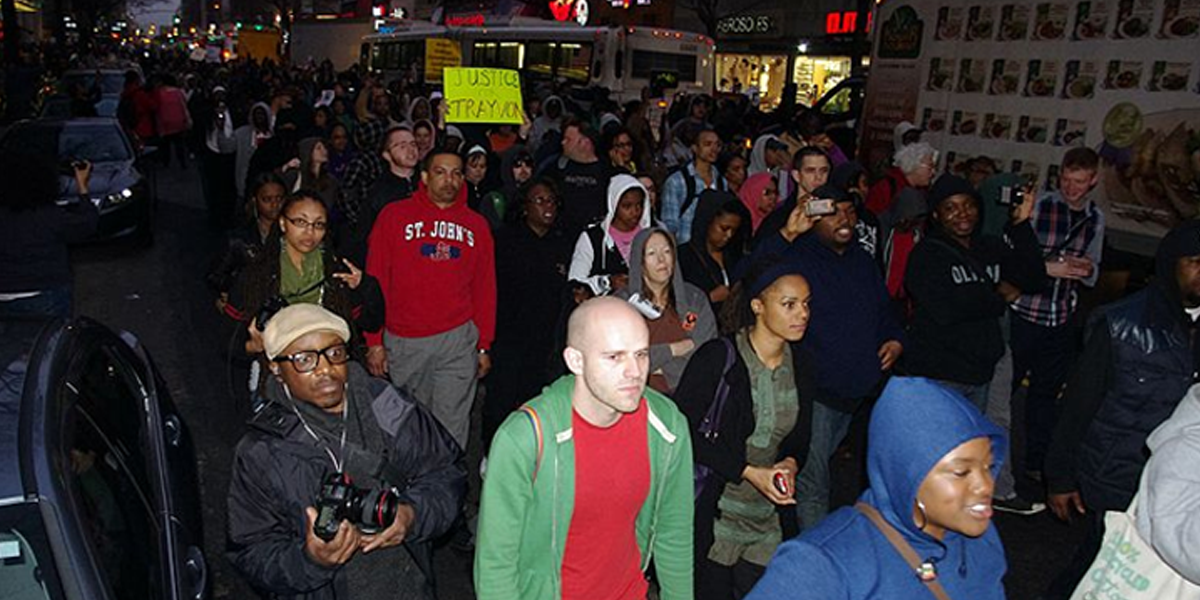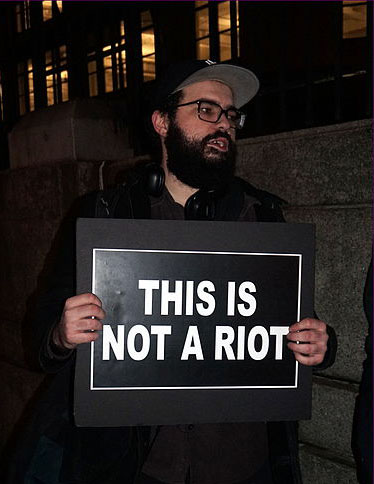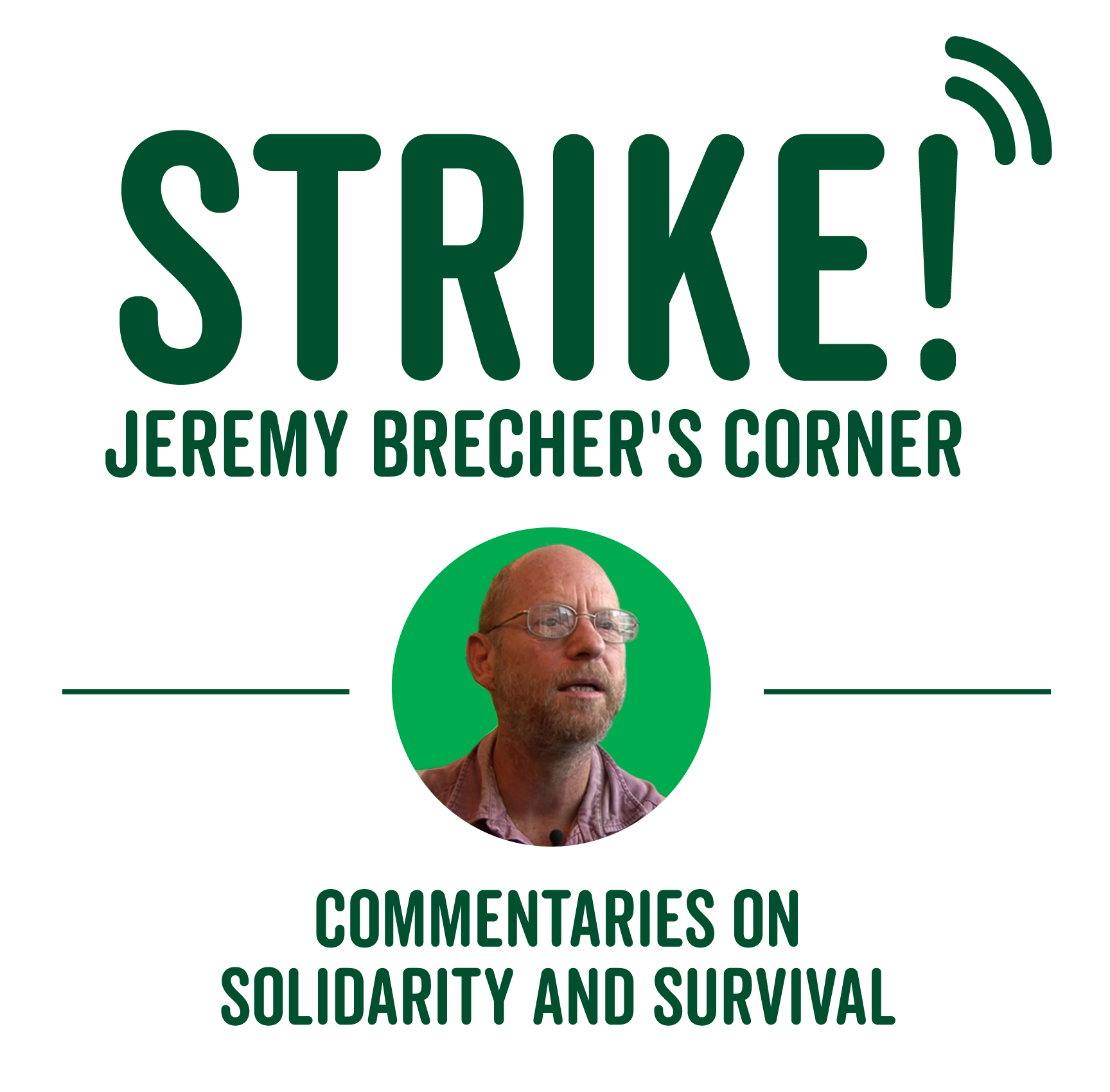In commemoration of George Floyd and in honor of all those fighting for racial justice against white supremacy, I devote this commentary to a history of the #BlackLivesMatter movement. I hope it will provide inspiration and insight for the next phase of this struggle. This account is based on the just published updated edition of my book Strike!

Photos from the Million Hoodies Union Square protest against Trayvon Martin’s shooting death in Sanford, Florida. Photo Credit: David Shankbone, Wikipedia Commons
On February 26, 2012, a neighborhood watch coordinator in Sanford, Florida, named George Zimmerman shot and killed unarmed African American seventeen-year-old Trayvon Martin. Two weeks later Zimmerman was charged with murder.[1] Zimmerman claimed self-defense. A year and a half later he was acquitted.
The killing, and even more the acquittal, kicked off a wave of prayer meetings, protests, and demonstrations. In Sanford, pastors held a prayer service. The Florida activist group Dream Defenders held a thirty-one-day sit-in in the office of Rick Scott, governor of Florida.[2] In Atlanta, more than two thousand people demonstrated in front of the CNN Center. In Washington, DC, a demonstration at the Justice Department demanded civil rights charges be brought against Zimmerman. People traveled from across the country for a vigil in New York City.[3] More than a million people signed an online petition, and rallies were held across the country demanding justice for Trayvon Martin. Hundreds of local and national organizations joined the protests.
The day Zimmerman’s acquittal was announced in July 2013, a domestic worker organizer in Oakland named Alicia Garza wrote a series of social media posts that she called “A Love Letter to Black People,” in which she decried “how little Black lives matter.” Her friend Patrisse Cullors, an organizer against police violence in Los Angeles, followed up with an impassioned declaration—“black bodies will no longer be sacrificed”—and closed with the tag “#blacklivesmatter.” Two days later she described “#blacklivesmatter” as “a movement attempting to visualize what it means to be black in this country,” to “provide hope and inspiration for collective action,” and to “build collective power to achieve collective transformation” rooted in “grief and rage” but pointed toward “vision and dreams.”[4] Opal Tometi, an immigrant rights organizer in Phoenix, created #BlackLivesMatter pages on Facebook, Tumblr, and Twitter where people could share “what they were doing to build a world where black lives matter.”[5]
The three black women knew each other through an organizer training group called Black Organizing for Leadership and Dignity (BOLD). All publicly identified as gay and explicitly connected #BLM with a wide range of human rights demands going far beyond race. Alicia Garza wrote, “Black Lives Matter affirms the lives of Black queer and trans folks, disabled folks, Black-undocumented folks, folks with records, women and all Black lives along the gender spectrum.” Its “guiding principles” include commitment to diversity, restorative justice, globalism, collectivity, transgender and queer affirmation, “loving engagement,” empathy, intergenerational work, unapologetic black identification, and the value of black women, black villages, black families. The phrase “black lives matter” would become the name and core assertion of a new social movement.
Ferguson
On August 9, 2014, in the St. Louis suburb of Ferguson, Missouri, a black teenager named Michael Brown was shot six times by a white police officer named Darren Wilson. Police left his dead body on the ground for four and a half hours. Local residents transmitted cell phone images of the body, which soon went viral around the world on Facebook and Twitter. Church groups arrived and began to pray, sing, and hug in an improvised vigil. Later a dumpster was set on fire.
The following Sunday, local pastors organized a gathering that erected handmade memorials where Brown had been killed. The crowd began chanting and marching, only to be blocked by a line of police. The crowd and the officers stood and shouted at each other. That night a gas station was looted and set on fire. The “riot” quickly hit national headlines. Two days after the killing, Mike Brown’s family held a press conference at which civil rights attorney Ben Crump declared that Brown had been “executed, in broad daylight, when it was clear he had no weapon.”[6]
The police killing of an unarmed black youth, coming on the heels of the nationally publicized deaths of Trayvon Martin and several other unarmed African Americans, sent echoes of centuries of racial oppression and unpunished murders and lynchings. A study of one hundred race riots since 1935 found they were almost all triggered by interactions with police. Between 2004 and 2014 there were more than ten thousand fatal shootings by on-duty police officers. Just fifty-four of these officers were ever charged with a crime, and just a handful were ever convicted.[7]
The killing of unarmed African Americans, in addition to being a symbol of injustice, was also widely seen as one more expression of a pervasive racism that persisted in the St. Louis area and throughout the country despite assertions that the election of a black president meant America had become a “post-racial society.” A study published in the St. Louis Post-Dispatch in 1997 had found: “Race pervades every St. Louis regional issue. It feeds the sprawl and all the costs of sprawl as people run from inner-city minorities. It explains the disparities in school funding and the extraordinary percentages of private and parochial school enrollments. It limits the geographic appeal of the new rail system because far-out suburbs don’t want too easy a connection to the core.”[8] The killing of Michael Brown vividly indicated that racial oppression remained pervasive a decade and a half later. When the Department of Justice investigated the Ferguson Police Department it discovered “a pattern or practice of unlawful conduct . . . that violates the First, Fourth, and Fourteenth Amendments to the United States Constitution, and statutory law.”[9] The revelation of what was virtually a police reign of terror against the Ferguson black community further indicated that the killing of Michael Brown was not an isolated incident but the effect of a larger problem.
The primary demand of the Brown family and the protesters was that the police officer who killed Michael Brown be held accountable by the legal system just as anyone else would be. Patricia Byrnes, a Ferguson protester and member of the local Democratic Party committee said, “There is this overwhelming feeling that they can shoot us, they can beat us—we can even have this stuff on video and the police officer still gets off.” [10]
New activist organizations began to emerge in Ferguson with names like Hands Up United and Millennial Activists United to coordinate daily marches, rallies, and civil disobedience. According to Washington Post reporter Wesley Lowery, who spent most of a year covering Ferguson, “Organized protests—unlike the half dozen or so nights of rioting—almost never resulted in violence, except for tear gas from responding officers.”[11] Local activists began putting out the Ferguson Protester Newsletter, which soon had more than twenty thousand readers.[12]
Anticipating the grand jury decision on Darren Wilson, the Ferguson officer who shot Brown, St. Louis residents and hundreds of journalists from around the world waited with widespread expectations of a violent response if Wilson was simply let go. On September 16 it was announced that the grand jury would not indict. Protests—violent and nonviolent—broke out immediately. Eight hundred St. Louis–area high school students pledged to walk out of school the Monday after it was announced that Mike Brown’s killer would not be charged.[13] According to police, on Monday night twenty-one fires were set, and at least twelve buildings were burned.
More than sixty people were arrested overnight for protest-related crimes in St. Louis County, according to St. Louis County police, including thirty-two arrests for felony burglary related to looting and twenty-nine for misdemeanor “unlawful assembly.” Ten police cars were damaged. Three officers suffered injuries. Governor Jay Nixon declared a state of emergency and sent twenty-two hundred Missouri National Guard members into Ferguson.[14]
On the second weekend in October, local groups like the Organization for Black Struggle and Missourians Organizing for Reform and Empowerment (MORE) and national groups like Black Lives Matter organized “Ferguson October,” bringing thousands of college students, clergy, and activists to Ferguson for marches, civil disobedience, and roadblocks of downtown intersections. Under the slogan “They Think It’s a Game,” protesters played hopscotch and jump rope as they blocked traffic. Protesters occupied Saint Louis University.[15] Demonstrations spread nationwide, often under the slogan “Black Lives Matter.” On October 13, 2014, demonstrators chanted and carried “Black Lives Matter” banners at a St. Louis Rams football game. The next day, Black Lives Matter Boston held a “Newbury Street Shutdown” protest.
Hundreds of people joined coordinated “freedom rides” to Ferguson from New York, Chicago, Portland, Los Angeles, Philadelphia, and Boston to protest in Missouri.[16] More than five hundred Black Lives Matter members from Baltimore, Berkeley, Los Angeles, Boston, Chicago, Columbus, Denver, Detroit, Houston, Nashville, New York City, Syracuse, Seattle, Tucson, Winston-Salem, Washington, DC, and Portland, Oregon, took part in nonviolent actions.[17]
On November 28, 2014, the Black Friday peak shopping day, demonstrators wearing “#BlackLivesMatter” T-shirts chained and locked themselves to Bay Area Rapid Transit (BART) trains and station platforms in West Oakland, demanding Wilson’s indictment; they shut down BART for more than two hours. On December 20, 2014, thousands of demonstrators occupied the Mall of America in Minneapolis, and twenty-five were arrested for failing to disperse.[18] Hundreds of organizations were involved in protesting Ferguson.[19] In the year starting June 2014, “Ferguson”—with or without a hashtag in front of it—was mentioned in 21.6 million tweets. There were 9.3 million tweets about Michael Brown.[20]
Impunity and protest

No Justice, No Peace. Photo Credit: Eric Garner Protest 4th December 2014, Manhattan, NYC, Wikipedia Commons
Meanwhile, a steady stream of racially charged events fed the fires of the Black Lives Matter movement. In New York City, a grand jury decided not to charge a Staten Island police officer who had killed a black man named Eric Garner with a chokehold.[21] In response to an earlier Cleveland police firing of 137 bullets into a car whose occupants turned out to have been unarmed, a federal review concluded that Cleveland police routinely exerted excessive force and pulled their guns—and their triggers—inappropriately.[22] Cleveland police shot and killed Tamir Rice, a child playing with a toy gun, two seconds after arriving at the “crime scene.”[23] In North Charleston, South Carolina, Walter Scott, an unarmed U.S. Marine Corps veteran, was shot multiple times and killed by police officer Michael Slager, who then placed his stun gun next to Scott’s body and told his superiors Scott had taken his gun and had been about to shoot him; unbeknown to Slager, the whole episode was caught on video.[24] In Baltimore, twenty-five-year-old Freddie Gray ran from police, was caught and arrested, and was dragged into a police van; when he arrived at the police station half an hour later he was in a coma. A week later he died as a result of a spinal cord injury.[25]
Each of these killings was met by demonstrations and other actions both locally and nationally, all of them regarded as part of the Black Lives Matter movement. In all but one of these cases the killers were known, but not one of them was ever indicted for a crime. The exception was the Freddie Gray case: six officers who took Gray into custody were charged for criminal offenses, but none were convicted.
Such impunity came to seem a more and more ubiquitous pattern. A team from the Washington Post identified nearly 400 fatal shootings by police officers during the first five months of 2015. Between January and August, twenty-four unarmed black people had been shot and killed by police.[26] Of 248 fatal shootings of black men by police in 2015, only six of the killers were ever charged with a crime.[27]
Beyond protesting, BLM activists developed constructive programs. BLM offshoot Campaign Zero proposed ten recommendations for how “we can live in a world where the police don’t kill people,” with detailed programs from body cameras to new police union contracts that became the basis for meetings with the White House and the leading Democratic presidential candidates.[28] Fifty organizations united as the Movement for Black Lives issued a platform that included scores of concrete proposals backed up by detailed policy briefs.[29]
The phrase “Black Lives Matter” encapsulated the sentiments of those protesting violence. It became almost immediately a hashtag, a social media site, a slogan used on thousands of signs and banners, the accepted name of a social movement, and an organization established by the originators of the phrase. By March 2016 the hashtag #blacklivesmatter had appeared more than twelve million times on Twitter.
The movement that came to be known as Back Lives Matter engaged both the poorest of the poor and upwardly mobile students. It used militant nonviolent direct action and disruption. It targeted police and political establishments, the media, and the public. It addressed problems facing a wide swath of the population. It involved broad coalitions with diverse identities. It used both face-to-face and virtual communications. It was coordinated by networks of social movements and NGOs. It was globally linked, multi-constituency, and multi-issue. It transformed understanding of the world and potential for action. Like mass strikes throughout history it involved challenging authority, spreading solidarity, and engaging in self-organization and self-management.
The Black Lives Matter movement had a significant impact on public opinion. The Pew Research Center reported that in 2011 only 28 percent of Americans said racism was a “big problem in our society.” By August 2017, 58 percent of Americans said it was. In August 2017 55 percent said they supported the Black Lives Matter movement, while 34 percent said they opposed it.[30] Participants in subsequent movements, from the Women’s March to the Parkland students’ strike for new gun laws, have identified Black Lives Matter as one of their inspirations.[31]
The killing of African-Americans by police is an old story. So is the impunity of the perpetrators. But when George Floyd was killed by a Minneapolis policeman, tens of thousands of people in more than 140 cities knew what to do – they took to the streets. Their action was not a result of any call from leaders or organizations. What made it possible was the legacy of the Black Lives Matter Movement.
[1] Garrett Chase, “The Early History of the Black Lives Matter Movement, and the Implications Thereof,” Nevada Law Journal 18, no. 3 (2018): 1091–1112, https://scholars.law.unlv.edu/nlj/vol18/iss3/11.
[2] Wesley Lowery, They Can’t Kill Us All: The Story of Black Lives Matter (Boston: Little, Brown, 2017), 170
[3] Chase, “Early History of the Black Lives Matter Movement,” 1094.
[4] “Early History of the Black Lives Matter Movement,” 1096.
[5] Ibid., 1098; Herbert G. Ruffin II, “Black Lives Matter: The Growth of a New Social Justice Movement,” BlackPast, August 23, 2015.
[6] Lowery, They Can’t Kill Us All, 27, 33–34
[7] Ibid., 29, 46.
[8] Quoted in ibid., 43–44.
[9] Chase, “Early History of the Black Lives Matter Movement,” 1102.
[10] Lowery, They Can’t Kill Us All, 45.
[11] Ibid., 59.
[12] Ibid., 68.
[13] Ibid., 198
[14] “Governor Nixon Orders 2,200 National Guard Troops into Ferguson,” NBC News, November 25, 2014, https://www.nbcnews.com/storyline/michael-brown-shooting/governor-nixon-orders-2-200-national-guard-troops-ferguson-n255931
[15] Lowery, They Can’t Kill Us All, 61, 152.
[16] Ibid., 88.
[17] Ruffin, “Black Lives Matter.”
[18] Chase, “Early History of the Black Lives Matter Movement,” 1104.
[19] Ruffin, “Black Lives Matter.”
[20] Michael McLaughlin, “The Dynamic History of #BlackLivesMatter Explained,” Huffington Post, February 29, 2016.
[21] Lowery, They Can’t Kill Us All.
[22] Ibid.
[23] Ibid., 75.
[24] Ibid., 115.
[25] Ibid., 133, 167.
[26] Ibid., 190–91.
[27] Ibid., 193.
[28] Ibid., 152.
[29] “Platform,” Movement for Black Lives, https://m4bl.org/policy-platforms/
[30] Samantha Neal, “Views of Racism as a Major Problem Increase Sharply, Especially among Democrats,” Pew Research Center, August 29, 2017, https://www.pewresearch.org/fact-tank/2017/08/29/views-of-racism-as-a-major-problem-increase-sharply-especially-among-democrats/.
[31] Adia Robinson, “After 5 Years, Black Lives Matter Inspires New Protest Movements,” ABC News,
July 21, 2018, https://abcnews.go.com/Politics/years-black-lives-matter-inspires-protest-movements/story?id=56702439.

